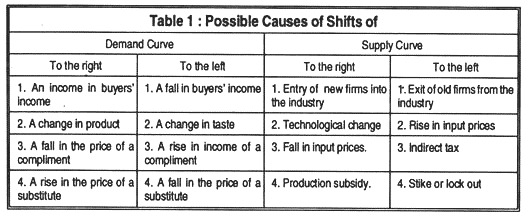Get the answer of: What do Changes in Demand and Supply Signify?
It is only possible to reach any conclusions regarding changes in demand and supply so long as we keep the rule of only considering one change at a time. Most statements in microeconomics should be prefaced with the phrase “all other things remaining constant” or ceteris paribus.
Changes in demand and supply:
It is important to distinguish between changes in the quantity demanded or supplied and changes in demand and supply. For example, lowering the price of a good will bring about a rise in the quantity demanded; it will not create a new demand.
ADVERTISEMENTS:
In Fig. 4, this is seen as a movement along the existing demand curve from point A to B. This is termed an extension demand. However, if there is a rise in income such that more is demanded at each price than before, this shifts the demand curve to the right as a new demand is created. This is termed an increase in demand. These principles hold true for supply as well.
A movement along an existing supply curve is termed an extension or a contraction of supply and a shift to a new supply curve is termed an increase or decrease in supply. Thus in Fig. 4 diagrams (a) and (c) represent changes in demand and supply.
Elasticity:
ADVERTISEMENTS:
The extent to which the quantity demanded or supplied changes in response to changes in price may vary enormously depending upon price elasticity of demand and price elasticity of supply.
Changes in Market Price:
Four possibilities for change:
If we consider all the possible changes in demand and supply it will be apparent that only four basic movements in the equilibrium price are possible. These are illustrated in Fig. 5.
ADVERTISEMENTS:
Other things being equal, an increase in demand will bring about an extension of supply so that more is supplied at a higher price [Fig.5 (a)]. A decrease in demand leads to a contraction of supply with less bought at a lower price [Fig.5 (b)]. Conversely, an increase in supply causes an extension of demand so that more is demanded at a lower price [Fig.5 (c)] and a decrease in supply causes a contraction of demand so that less is bought at a higher price [Fig.5 (d)].
Four Laws of Demand and Supply:
In this context we may refer to four Laws of Demand and Supply:
1. The first law:
If the market demand curve of a commodity alone shifts to the right (due to, say, an increase in buyers’ income) the equilibrium quantity and price will both rise.
2. The second law:
If the market demand curves alone shifts to the left, the equilibrium quantity and price will both fall.
3. The third law:
ADVERTISEMENTS:
If the market supply curve alone shifts to the right (due to technological progress or an increase in the number of firms into the industry) the equilibrium quantity will increase but price will fall.
4. The fourth law:
If the supply curve alone shifts to the left (due to the imposition of a sales tax on the economy) equilibrium quantity will fall, and price will rise.


